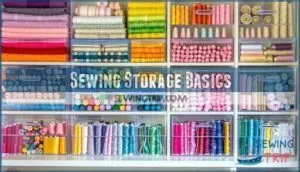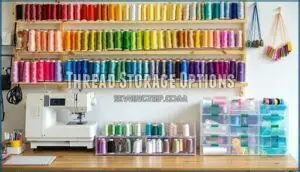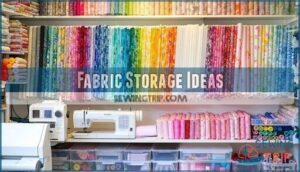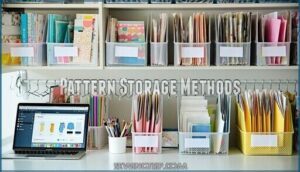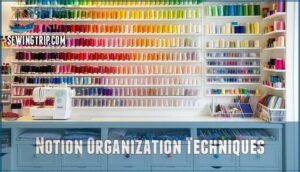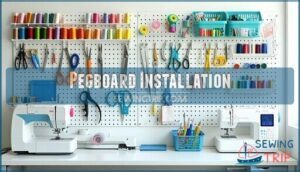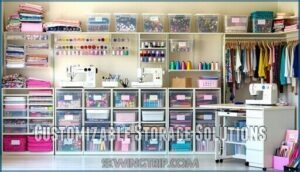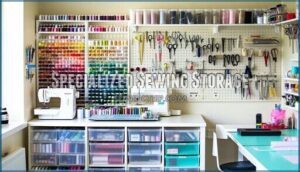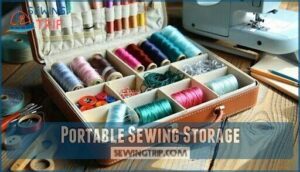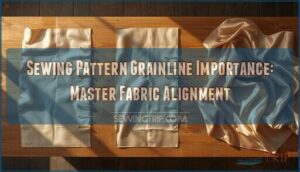This site is supported by our readers. We may earn a commission, at no cost to you, if you purchase through links.

Start with clear stackable containers or bins—labels are your best friend here.
Store threads in dedicated racks or small plastic trays to keep them tangle-free.
Fabrics? Fold them neatly and tuck them into cube storage units like Ikea’s Kallax.
If you’ve got patterns, file them in magazine holders or expandable folders.
A pegboard is a lifesaver for tools like scissors, measuring tapes, and rotary cutters—you’ll feel like a pro crafter just looking at it!
Ready to take your sewing space to the next level?
Keep reading!
Table Of Contents
Key Takeaways
- Use clear stackable containers and label them to keep your sewing supplies organized and easy to find.
- Store fabric neatly with folding, color coordination, and clear bins to protect it and save space.
- Keep threads tangle-free on racks or in boxes, and group them with matching bobbins for quick access.
- Use pegboards and magnetic holders to make tools like scissors and rotary cutters accessible and clutter-free.
Sewing Storage Basics
Keeping your sewing supplies organized doesn’t have to be overwhelming if you start with the basics.
Start with the basics—simple storage solutions keep your sewing supplies neat, accessible, and spark creativity in your workspace.
By using sturdy, stackable containers and clear storage bins, you can protect your tools while keeping everything easy to find.
General Storage Solutions
Let’s keep your sewing room storage organized and efficient!
Start with container durability—choose stackable bins and drawers for long-term use.
Clear identification is a breeze with see-through containers, making life easier.
Drawer dividers are lifesavers for tiny notions.
Don’t forget sustainable storage; reuse jars or tins.
Consider using a pegboard thread storage for an accessible solution.
Every sewing organization step optimizes space while keeping your supplies neat and accessible!
Sterilite Storage Bins
Sterilite storage bins are a lifesaver for sewing supplies storage.
With durable, stackable designs, they’re perfect for fabric storage while maximizing space.
The clear view benefits make finding items a breeze, and their size options fit seamlessly into various setups.
You can find stackable bin options online.
Grab them at Target for reliable, efficient sewing room storage that keeps your workspace tidy and stress-free, providing a great solution for sewing supplies.
Ikea Expedit/Kallax Cube Storage
Ikea Expedit/Kallax is perfect for sewing supplies storage, thanks to its cube dimensions and customizable options.
The Ikea Kallax is a stylish and customizable solution, making sewing supply storage both efficient and visually appealing.
Use shelf dividers or inserts to store fabric and keep notions tidy.
Consider these sewing room organization tips:
- Add baskets for clean, concealed fabric storage.
- Use clear boxes for quick-view supplies.
- Hack ideas: Insert pegboards for vertical sewing storage ideas.
It’s stylish and functional!
Stackable Containers
Stackable containers are a game-changer for sewing storage ideas.
With modular designs and container durability, they optimize space while holding significant weight.
Clear storage bins make finding notions easy, and labeling systems keep everything sorted.
Choose sturdy plastic containers for heavy tools or storage boxes for lighter supplies.
These options make staying organized a breeze.
They offer various benefits, including easy identification and space optimization, as shown in the following table:
| Feature | Benefit | Example Use |
|---|---|---|
| Clear Bin Design | Easy identification | Quick access to thread colors |
| Modular Stacking | Space optimization | Fits custom shelf dimensions |
| Durable Materials | Supports heavy items | Sewing machine feet storage |
| Lightweight | Portable | Ideal for travel kits |
| Labeling Options | Organized system | Categorizing zippers by length |
The use of clear storage bins and modular stacking designs allows for efficient use of space and easy access to sewing supplies.
Storing Sewing Essentials
Keeping your sewing essentials tidy doesn’t have to be overwhelming if you use clever storage techniques.
From threads to patterns, a little planning goes a long way in preserving your tools and making your creative space more functional.
Thread Storage Options
After organizing your basics, it’s time to tackle thread storage. A thread rack can keep spools visible and handy, while thread boxes protect against dust and sunlight.
Spool size matters—choose a thread holder that fits yours snugly. Consider a dedicated thread organizer for maximum space utilization.
Portable thread storage, like zipper pouches or small totes, makes sewing on-the-go easy. Try color-coded thread for a visually satisfying system!
Fabric Storage Ideas
Keep your fabric stash neat with simple fabric storage solutions.
Try fabric folding around boards for tidy shelves or bolt storage for large collections. Use color coordination to sort by shades and patterns.
Label scraps for instant use, or try vacuum sealing bulky pieces.
Clear containers help with sewing notions visibility.
These fabric storage ideas make fabric organization easy, saving space and time for your next creation, using methods like color coordination and vacuum sealing to keep your stash tidy.
Pattern Storage Methods
Storing sewing patterns can be simple and effective. Use clear plastic envelopes or manila folders for organized paper pattern filing.
Add pattern alteration notes directly inside envelopes for easy updates. Digitally, tools like Evernote help with pattern cataloging systems and sharing within the sewing pattern community.
For accessibility, consider creative storage methods like metal hooks. Combine physical and digital pattern storage for accessible, protected sewing pattern resources, using effective methods.
Notion Organization Techniques
You’ve tackled patterns—now let’s tame those sewing notions.
Smart organization keeps clutter at bay and creativity flowing.
- Use portable caddies for grab-and-go convenience.
- Try container repurposing for eco-friendly storage solutions.
- Install magnetic strips inside drawers to secure pins.
- Craft DIY dividers to sort trims neatly.
- Employ labeling strategies for quick access.
Keep things tidy, stress-free, and inspiring!
Sewing Room Organization
You don’t need a massive makeover to keep your sewing room tidy and functional.
By adding smart tools like pegboards, magnetic holders, and hanging storage, you can save space and make finding your supplies a breeze.
Pegboard Installation
A pegboard can transform your sewing room storage into a masterpiece of organization.
Plan your layout carefully—consider weight limits for heavier tools. Choose hooks and baskets that match your supplies, like scissors or thread spools.
Pegboard mounting is simple, and you’ll love the customization ideas it offers. Consider designated work zones for different tasks to further optimize your space.
It’s workspace storage that keeps essentials within arm’s reach!
Customizable Storage Solutions
Your sewing space doesn’t need to be a cluttered jungle.
Create order with:
- DIY dividers to organize small tools and notions.
- Adjustable shelving for bulky or odd-shaped items.
- Personalized labels for quick access to supplies.
- Modular systems for flexible, future-friendly layouts.
- Use space optimization tricks like stacking clear bins.
These sewing room storage solutions keep creativity flowing!
Magnetic Holders
Magnetic holders are lifesavers for keeping small tools like needles and pins handy.
Use magnetic tape or DIY magnetic strips near your sewing table for easy access. Choose ones with enough weight capacity for heavier scissors.
Safety is key—avoid placing magnets where kids might reach. With smart holder placement, sewing storage becomes organized and accident-free!
Hanging Storage Options
Spruce up your sewing room with hanging storage. It keeps tools within arm’s reach and clears up workspace clutter.
Try these ideas:
- Install closet rods for hanging fabric display.
- Use over-the-door organizers for sewing storage.
- Add wall hooks for rulers and templates.
- Try hanging racks for thread spools.
- Use fabric storage bags clipped to closet poles, which helps in keeping the workspace organized with hanging storage.
Specialized Sewing Storage
You’ve got plenty of sewing tools, and keeping them easy to find makes a world of difference.
With the right storage ideas, you can protect your supplies and stay organized without breaking a sweat.
Sewing Machine Accessory Storage
Keep your sewing machine accessories tidy and easy to find with these storage tricks. Use divided containers for feet organization, needle storage, and bobbin management.
Add a small tray for oiling tools and maintenance supplies. Compact boxes fit snugly in sewing machine storage options.
Here’s a quick guide:
| Item | Storage Solution | Purpose |
|---|---|---|
| Presser Feet | Divided Container | Organization |
| Bobbins | Bobbin Clamps | Tangle-Free |
| Needles | Small Jewelry Box | Easy Access |
| Oil Tools | Tray or Tin | Maintenance |
| Supplies | Compact Box | Tidy Storage |
The goal is to have all your sewing machine accessories organized and within reach, making your sewing experience more efficient and enjoyable, with easy access to all your tools and supplies, and keeping them in a tidy storage system.
Serger Accessory Storage
Tidy up serger feet, thread cones, and machine accessories with a multipurpose case.
Use stackable boxes for easy access to needle storage and bobbin storage.
Store tweezers, oiling tools, and waste bins in zippered pockets or small compartments.
A double-sided thread holder works wonders for thread storage.
Keep it compact and transportable for hassle-free organization!
Rotary Cutter Blade Storage
Rotary cutter blade storage doesn’t have to be tricky! Here’s how to keep those sharp sewing tools safe and organized:
- Use sturdy storage containers to separate blades by size.
- Add safety caps to protect both blades and fingers.
- Track blade lifespan with labeled compartments.
Store dull blades for sharpening methods or proper blade disposal later.
Stay safe while crafting with your organized tools!
Scissor Storage Options
Wall-mounted racks keep scissors handy and safe, while ergonomic scissor storage prevents scratches and strain.
A travel scissor case can protect your sewing tools on the go.
For sewing room storage, add a magnetic holder near your cutting table. Many users find a scissor storage solution ideal for organization.
Don’t forget: sewing accessories last longer with proper care! Store sharpening tools nearby to maintain precision.
Portable Sewing Storage
When you’re on the go or short on space, portable sewing storage keeps your tools neat and ready to use.
From handy boxes to creative containers, you can pack everything without losing track of the essentials.
Repurposed Storage Containers
Upcycling for organization is smart and eco-friendly! Turn everyday items into perfect craft storage.
Repurpose takeout containers for notions, use jars for stray buttons, or transform tins into portable sewing kits.
Embrace container alternatives like food containers or cookie tins—they’re great for sorting thread or scissors.
A sewing box alternative like a tackle box can also be a robust option.
Recycling for storage isn’t just sustainable sewing—it’s fun and functional DIY creativity in action!
Sewing Box Organization
When your sewing supplies need a tidy home, a well-organized sewing box is your best friend. Use compartment dividers for button storage, thread, or needles. Tray arrangements keep notions storage easy to reach. Opt for durable box materials for portability.
Plan customization ideas to fit your needs. Portable boxes guarantee everything’s sorted, compact, and ready!
- Group needles by size.
- Use trays for small notions.
- Add labels for quick access.
- Store thread spools upright.
- Include elastic bands for scissors.
Travel Storage Solutions
Packing for sewing on the go? Travel storage keeps your Sewing Kit ready and Portable Machines safe.
Use compact, TSA-compliant cases and zippered bags for space-saving solutions. Compression bags protect bulky sewing project storage while keeping things tidy.
For sewing room storage on the move, durable travel organizers guarantee project protection. Smart storage solutions make traveling with sewing essentials stress-free! Compression bags also play a role in keeping things tidy.
Project Bag Options
When picking project bags for your sewing projects, think about the materials, sizes, and features you need most.
Clear plastic bags offer visibility, while canvas DIY bags are durable and customizable.
Choose closure types like zippers or drawstrings to keep everything secure. Keep bag sizes flexible—small for tools, larger for fabrics.
These handy bags simplify sewing project storage and keep things tidy!
Frequently Asked Questions (FAQs)
What is the best way to store sewing thread?
Store thread on a wall-mounted rack for easy access and tangle prevention.
Keep dust off by using a clear cover or box.
Pair bobbins with threads using simple holders to avoid mismatched colors and chaos!
How to store your sewing fabric?
Fabric piles up fast, so treat it like treasure—fold neatly, sort by color or type, and stash in clear bins for visibility.
Label everything, and keep humidity low to avoid mildew ruining your stash!
What is the best way to store sewing patterns?
Sewing patterns crave order.
File them in clear plastic envelopes or expandable folders, grouping by type or season.
Label everything for quick grabs, and keep them upright in bins or filing cabinets to prevent creasing, this helps to maintain the order.
What are the best materials to store sewing patterns?
Think of sewing patterns as precious recipes—you’ll want acid-free folders or envelopes to prevent yellowing.
Store them flat in labeled plastic bins or hanging file folders to keep them organized, protected, and ready for action.
How long do sewing patterns last when stored properly?
Properly stored sewing patterns can last decades.
Keep them in acid-free envelopes or archival sleeves to avoid yellowing or brittleness.
A cool, dry space works best—think closet shelves, not a humid basement or attic.
How can I store vintage sewing patterns safely?
Keep vintage patterns safe by wrapping them in acid-free tissue paper, storing in archival envelopes or sleeves, and placing them upright in a cool, dry space.
Avoid direct sunlight or damp areas to prevent damage.
What is the best way to organize sewing magazines?
Sort sewing magazines by topic or date in magazine holders or file boxes.
Label them clearly for quick access.
Store in a dry spot away from sunlight to prevent fading, and they’ll stay pristine!
How do I prevent fabric from fading in storage?
Store fabric in acid-free tissue or cotton bags away from sunlight and humidity.
Seal delicate pieces in airtight bins.
Poke air holes in plastic covers to let it breathe.
Your fabric will thank you!
What solutions exist for storing oversized cutting mats?
Ever wondered if tucking cutting mats under the bed is genius or madness?
It works!
For oversized mats, slide them under beds, hang them with clips on pants hangers, or prop them behind a door.
How can I organize fabric scraps by size and type?
Sort fabric scraps into clear bins or bags by size—small, medium, large—and type like cotton or fleece.
Label each container clearly.
Tackle organizing while watching your favorite show; it makes the task less tedious!
Conclusion
Imagine a sewing space where everything has its place, from neatly folded fabric to tangle-free threads.
Organizing your supplies doesn’t have to be overwhelming, use stackable containers, pegboards, and cube storage to keep tools and materials accessible and tidy.
With simple solutions like labeled bins and expandable folders, you’ll spend less time searching and more time creating.
Now that you know how to store sew supplies, it’s your turn to craft your dream workspace!
- https://www.harborfreight.com/24-container-storage-box-90243.html
- https://www.instagram.com/urbanstylejantine/
- https://www.target.com/p/3-drawer-medium-cart-white-room-essentials-8482/-/A-75666886
- https://www.ikea.com/us/en/p/alex-drawer-unit-on-casters-white-40196241/
- https://mellysews.com/how-to-store-sewing-patterns-pdf-pattern-storage/

